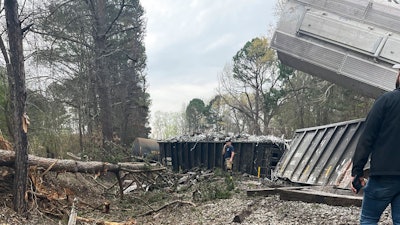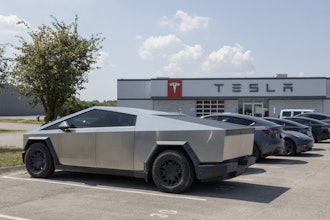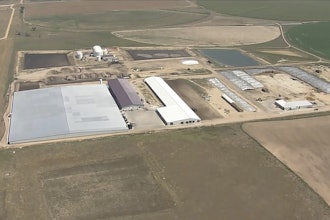
SPRINGFIELD, Ohio (AP) — A Norfolk Southern train that derailed in Alabama earlier this month lacked required alignment control couplers for two of its locomotives and a company inspection did not identify their absence, federal investigators said Monday.
The notation comes in one of three preliminary reports issued Monday by the National Transportation Safety Board about Norfolk Southern train accidents this month as the board investigates the railroad's safety practices after the fiery February derailment and toxic chemical burn in East Palestine, Ohio.
In a report released Monday about a March 9 derailment of two locomotives and 37 rail cars in Anniston, Alabama, the safety board said two of the train's six locomotives were "waybill locomotives," or towed cars not used for any tractive power. The cars weren't equipped with alignment control couplers that "resist lateral coupler movement under compressive in-train forces." A company rule bars towing waybill locomotives without such couplers, the report said.
The waybill locomotives were coupled together and picked up from Bluffton, Indiana, on Feb. 24 and a Norfolk Southern inspection before the first movement involving the coupled locomotives "did not identify the absence of alignment control couplers," the safety board said.
A company spokesperson said in an e-mail Monday that "these locomotives were not owned by Norfolk Southern and the couplers on these locomotives are not common on our network."
"We have taken immediate action to update our manuals with photos and details to implement training with our crews. Safety is a priority at NS and we'll continue working with the NTSB to identify the final cause of this derailment and implement any other necessary changes," said Connor Spielmaker, a senior communications manager with Norfolk Southern.
No injuries were reported; three derailed tank cars were carrying hazardous material residue but all remained intact, the report said. The safety board said future investigation will focus on Norfolk Southern "communication, maintenance, and inspection practices" as well as locomotive and railcar positioning and train handling.
The safety board also said it was examining industry-wide standards and practices regarding railcar wheel and axle assemblies after a train derailment in Ohio earlier this month. Eight wheelsets were recovered from two of the 28 Norfolk Southern railcars that derailed March 4 near Springfield. Photographs taken after the derailment showed three wheels from the eight wheelsets "exhibited movement on their axles," the board said.
Five days after that derailment, the Association of American Railroads issued an equipment inspection order advising railroads to remove from service — wheelsets mounted by National Steel Car between August and March. The association said railroads nationwide initially identified 675 cars affected by the advisory and pulled them off the tracks.
The wheelsets and other material from the crash along with wheelsets from elsewhere in the Norfolk Southern fleet have been undergoing analysis since last Wednesday at a Norfolk Southern facility in Altoona, the safety board said.
"Future investigative activity will focus on failure analysis of the subject wheelsets and on industry-wide standards and practices for railcar wheel and axle assembly processes, specifications, and quality control," the safety board said Monday.
Soon after the Springfield crash, the safety board announced a broad look at Norfolk Southern's safety culture — the first such investigation within the rail industry since 2014 — and said it had sent investigation teams to look into five significant accidents involving Norfolk Southern since December 2021.
In a preliminary report on a March 7 accident that killed a Norfolk Southern conductor when a train and dump truck collided as they simultaneously entered a private rail crossing at a Cleveland steel plant, the safety board said the train was going 9 mph (14 kph), less than the 10 mph (16 kph) limit within the Cleveland-Cliffs Inc. steel plant. The Federal Railroad administration later urged proper training, oversight and crew communication at highway–railroad grade crossings.
Following the Feb. 3 derailment outside East Palestine, Ohio, Norfolk Southern announced plans to improve the use of detectors placed along railroad tracks to spot overheating bearings and other problems. Investigators have said the crew got a warning from such a detector but couldn't stop the train before more than three dozen cars came off the tracks and caught fire.
Half of the town of about 5,000 had to evacuate for days when responders intentionally burned toxic chemicals in some derailed cars to prevent an uncontrolled explosion, leaving residents with lingering health concerns. Government officials say tests haven't found dangerous levels of chemicals in the air or water in the area.






















